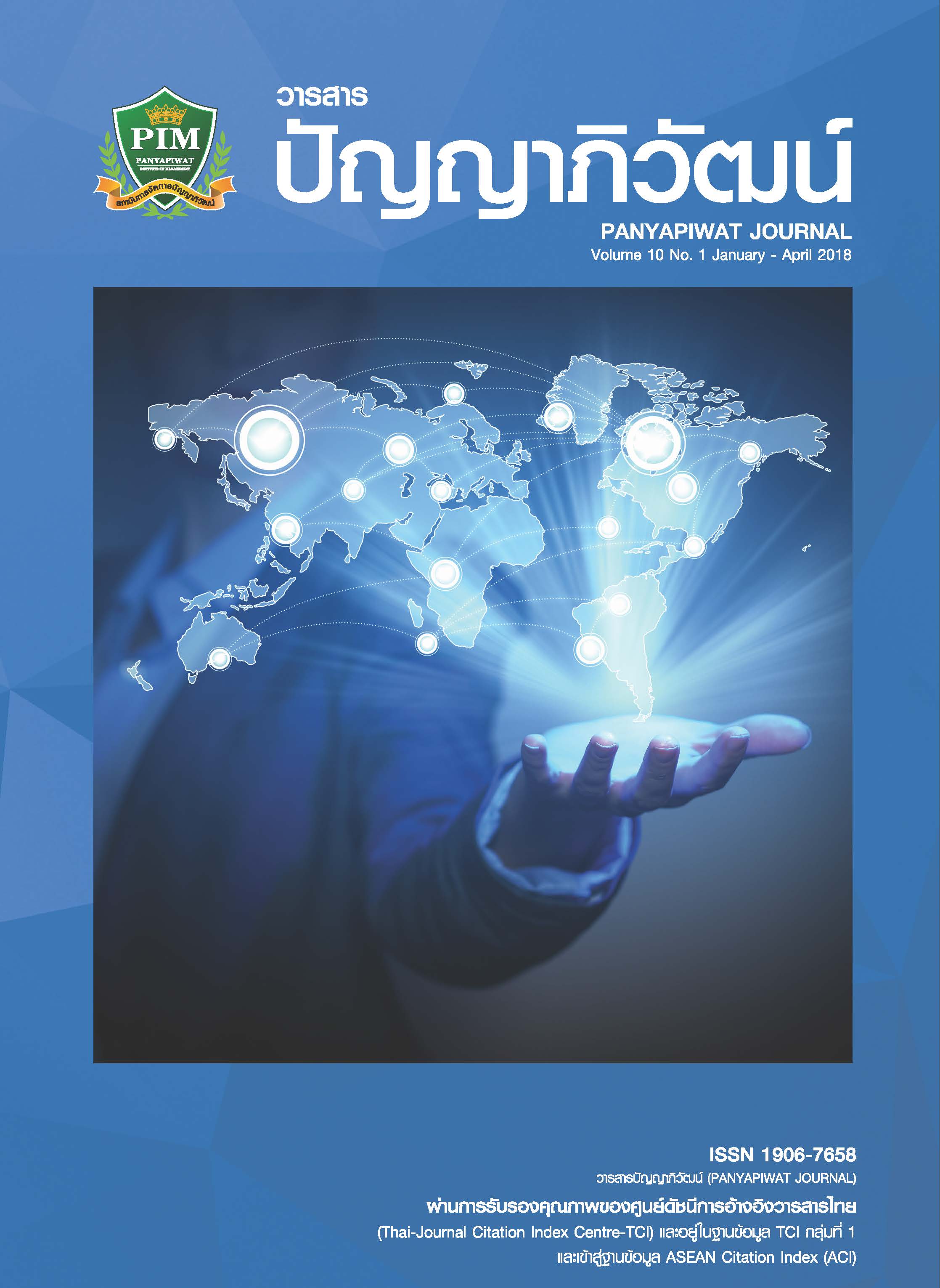อิทธิพลคั่นกลางของทุนโครงสร้างและการเป็นผู้ประกอบการในการถ่ายทอดทุนเชิงความสัมพันธ์สู่ผลิตภาพสำหรับอุตสาหกรรมอัญมณีและเครื่องประดับไทย
Main Article Content
บทคัดย่อ
การวิจัยครั้งนี้มีวัตถุประสงค์เพื่อ 1) ศึกษาทุนเชิงความสัมพันธ์ ทุนโครงสร้าง การเป็นผู้ประกอบการ และผลิตภาพของอุตสาหกรรมอัญมณีและเครื่องประดับไทย และ 2) ศึกษาทุนโครงสร้างและการเป็นผู้ประกอบการในฐานะตัวแปรคั่นกลางที่เชื่อมโยงทุนเชิงความสัมพันธ์สู่ผลิตภาพของอุตสาหกรรมอัญมณีและเครื่องประดับไทย งานวิจัยนี้เป็นการวิจัยเชิงปริมาณ (quantitative research) ด้วยวิธีการวิจัยเชิงสำรวจ (survey research) กับประชากร กลุ่มตัวอย่างที่ใช้ในการวิจัยคือ ผู้ประกอบการอุตสาหกรรมอัญมณีไทย จำนวน 128 ตัวอย่าง เครื่องมือที่ใช้เป็นแบบสอบถาม สถิติที่ใช้คือ วิเคราะห์ด้วยค่าร้อยละ ค่าเฉลี่ย ส่วนเบี่ยงเบนมาตรฐาน และการวิเคราะห์ตัวแบบสมการโครงสร้างโดยใช้โปรแกรม PLS Graph 3.0
ผลการวิจัยพบว่า 1) ทุนเชิงความสัมพันธ์ ทุนโครงสร้าง การเป็นผู้ประกอบการ และผลิตภาพขององค์การมีค่าเฉลี่ยรวมอยู่ในระดับมาก และ 2) ทุนโครงสร้างและการเป็นผู้ประกอบการเป็นปัจจัยคั่นกลางที่เชื่อมโยงทุนเชิงความสัมพันธ์สู่ผลิตภาพเข้าด้วยกัน แต่การเป็นผู้ประกอบการไม่เป็นปัจจัยคั่นกลางระหว่างทุนโครงสร้างกับผลิตภาพขององค์การ
The objectives of the research were: 1) to study the relational capital, structural capital, entrepreneurship, and the productivity of Thailand’s gems and jewelry industry, 2) to study the structural capital and entrepreneurship as linkage mediators for relational capital to the productivity of Thailand’s gems and jewelry industry. In the quantitative phase of investigation, the researcher deployed a survey research methodology. The research samples population included 128 operators of the Thailand’s gems and jewelry industry. Using a questionnaire as a research instrument to collect data, the researcher distributed copies of the questionnaire to the members of the sample population. Using techniques of descriptive statistics, the researcher analyzed the data collected in terms of percentage, mean and standard deviation. Furthermore, the researcher employed structural equation model (SEM) analysis by virtue of using the Partial Least Square (PLS) Graph 3.0 computer software application.
The research results revealed that relational capital, structural capital, entrepreneurship, and organizational productivity showed overall means at a high level. The results obtained by the structural equation modeling analysis of factors influencing organizational productivity revealed that 1) influences structural capital and entrepreneurship as the mediating exhibited correlation between relational capital and organizational productivity, 2) influences entrepreneurship as the mediating exhibited no correlation between structural capital and organizational productivity.
Article Details
“ข้าพเจ้าและผู้เขียนร่วม (ถ้ามี) ขอรับรองว่า บทความที่เสนอมานี้ยังไม่เคยได้รับการตีพิมพ์และไม่ได้อยู่ระหว่างกระบวนการพิจารณาลงตีพิมพ์ในวารสารหรือแหล่งเผยแพร่อื่นใด ข้าพเจ้าและผู้เขียนร่วมยอมรับหลักเกณฑ์การพิจารณาต้นฉบับ ทั้งยินยอมให้กองบรรณาธิการมีสิทธิ์พิจารณาและตรวจแก้ต้นฉบับได้ตามที่เห็นสมควร พร้อมนี้ขอมอบลิขสิทธิ์บทความที่ได้รับการตีพิมพ์ให้แก่สถาบันการจัดการปัญญาภิวัฒน์หากมีการฟ้องร้องเรื่องการละเมิดลิขสิทธิ์เกี่ยวกับภาพ กราฟ ข้อความส่วนใดส่วนหนึ่งและ/หรือข้อคิดเห็นที่ปรากฏในบทความข้าพเจ้าและผู้เขียนร่วมยินยอมรับผิดชอบแต่เพียงฝ่ายเดียว”
เอกสารอ้างอิง
Abdullah, K. A. S. & Mahmood, R. (2012). Total quality management, entrepreneurial orientation and organizational performance: The role of organizational culture. African Journal of Business Management, 6(13), 4717-4727.
Behram, N. K. & Ozdemirci, A. (2014). The empirical link between environmental conditions, organizational culture, corporate entrepreneurship and performance: The mediating role of corporate entrepreneurship. International Journal of Business and Social Science, 5(2), 264-276.
Bemolak, I. (1997). Effective measurement and successful elements of company productivity: The basis of competitive-ness and world prosperity. International Journal of Production Economics, 52(1), 203-213.
Bollen, L., Vergauwen, P. & Schnieders, S. (2005). Linking intellectual capital and intellectual property to company performance Management Decision, 43(9), 1161-1185.
Boonyoo, T., Rungruangwuddikrai, N., Piriyakul, M. & Khantanapha, N. (2016). Serial mediated effects of intellectual capital and entrepreneurship in transmitting organizational culture to performance of Bus Body Industry. Doctor of Philosophy in Social Sciences Association Ramkhamhaeng University, 6(1), 78-94. [in Thai]
Chin, W. W. (2001). PLS graph user's guide version 3.0. Retrieved April 8, 2016, from https://www.Pubinfo.vcu.edu/carma/documents
Deepateep, A., Knantanapha, N. & Piriyakul, R. (2017). The effects of the factors of organizational culture, communication, and empowerment on organizational citizenship behaviors after bank mergers and acquisitions as transmitted by role stress. Doctor of Philosophy in Social Sciences Association Ramkhamhaeng University, 7(1), 120-135. [in Thai]
Gurbuz, G. & Aykol, S. (2009). Entrepreneurial management, entrepreneurial orientation and Turkish small firm growth. Management Research News, 32(4), 321-336.
Hannula, M. (2002). Total productivity measurement based on partial productivity ratios. International Journal of Production Economics, 78(1), 57-67.
Mehdivand, M., Zali, M. R., Madhoshi, M. & Kordnaeij, A. (2012). Intellectual capital and nano-businesses performance: The Moderating role of entrepreneurial orientation. European Journal of Economics, Finance and Administrative Sciences, 52, 147-162.
Morgan, N. A., Vorhies, D. W. & Schlegelmilch, B. B. (2006). Resource performance relationships in industrial export ventures: The role of resource inimitability and substitutability. Industrial Marketing Management, 35(5), 621-633.
Ngah, R. & Ibrahim, A. R. (2009). The relationship of intellectual capital, innovation and organizational performance: A preliminary study in Malaysian SMEs. International Journal of Management Innovation Systems, 1(1), 1-13.
Office of Small and Medium Enterprise Promotion. (2013). Strategy and Action Plan for Small and Medium Enterprises. Retrieved November 10, 2017, from https://thaifranchisedownload.com/dl/group154 658720140110154445.pdf [in Thai]
Pratono, A. H. & Mahmood, R. (2014). The moderating effect of environmental turbulence in the relationship between entrepreneurial management and firm performance. Universal Journal of Management, 2(7), 285-292.
Rafiei, M., Feyzi, T. & Azimi, H. (2011). Intellectual capital and its effect in economic performance: A case study in Iranian automotive industry. Journal of American Science, 7(6), 495-507.
Sofian, S., Tayles, M. E. & Pike, R. H. (2004). Intellectual capital: An evolutionary change in management accounting practices. Retrieved May 28, 2016, from https://www.brad.ac.uk/acad/management
Sonmanee, K., Piriyakul, R. & Skulitsariyaporn, C. (2016). The influence of the advantage of franchisor justice, support and franchisor brand image on the success of the fresh roasted coffee franchise business in Thailand. Panyapiwat Journal, 8(2), 11-24. [in Thai]
Tahooneh, S. & Shatalebi, B. (2012). The relationship between intellectual capital and organizational creativity among faculty members of Islamic Azad University, Khorasgan Branch in 2011-2012. Life Science Journal, 9(4), 5626-5632.
Talebi, K. & Bahamir, A. (2012).Identification of intellectual capital effects on promoting organization entrepreneurship.International Journal of Business economics & Management Research, 26), 37-48.
Wang, C. L. & Ahmed, P. K. (2004). The development and validation of the organizational innovativeness construct using confirmatory factor analysis. European Journal of Innovation Management, 7(4), 303-313.
Wang, G. L. (2012). A study of how the organizational culture of international tourist hotels affects organizational performance: Using intellectual capital as the mediating variable. The Journal of Global Business Management, 8(1), 189-201.
Westland, J. C. (2010). Lower bounds on sample size in structural equation modeling. Electronic Commerce Research and Applications, 9(6), 476-487.
Wingworn, B., Noithonglek, T. & Piriyakul, M. (2015). The mediating effect of innovation, family constitution, networking on entrepreneurship and family business performance. Journal of the Association of Researchers, 21), 46-61. [in Thai]


